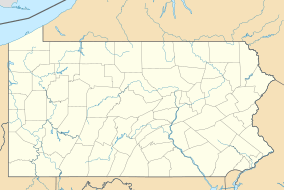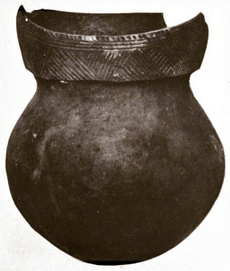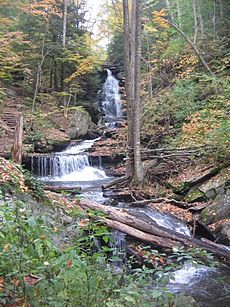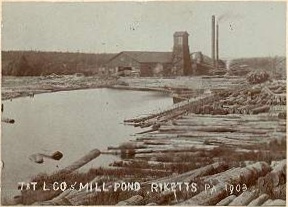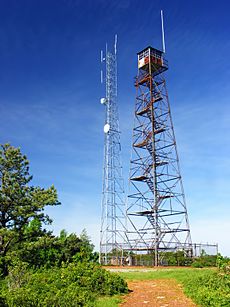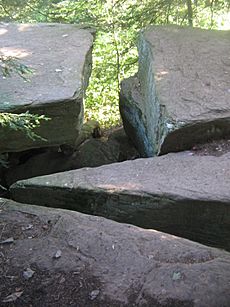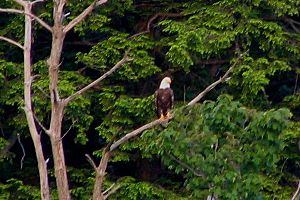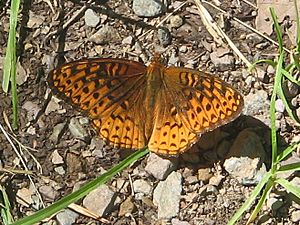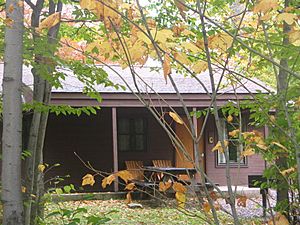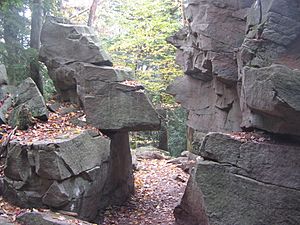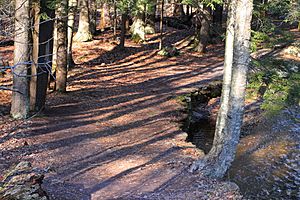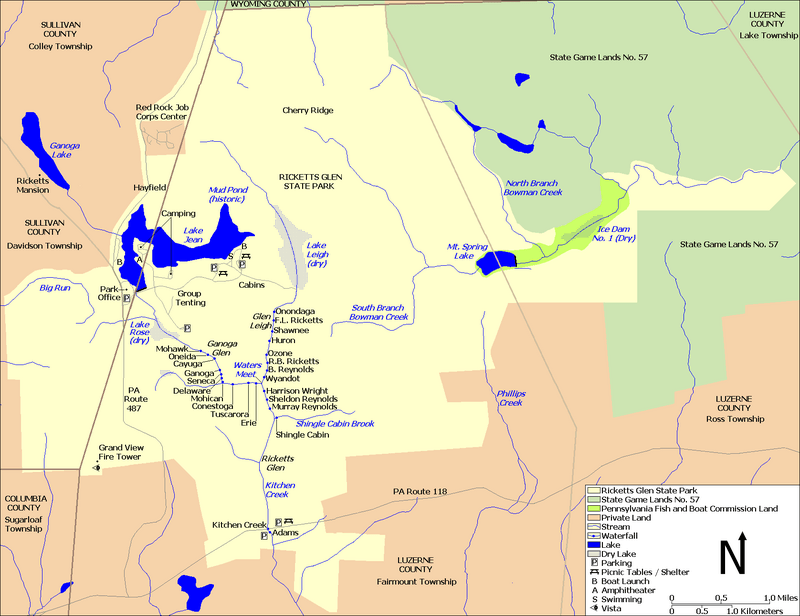Ricketts Glen State Park facts for kids
Quick facts for kids Ricketts Glen State Park |
|
|---|---|
|
IUCN Category V (Protected Landscape/Seascape)
|
|
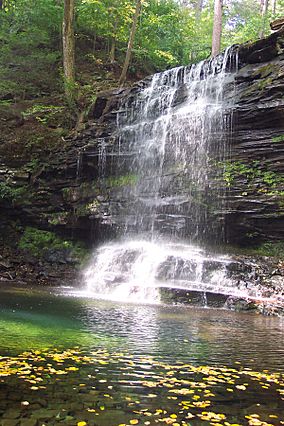
Harrison Wright Falls, 27 feet (8.2 m), at Ricketts Glen State Park
|
|
| Location | Pennsylvania, United States |
| Area | 13,046.54 acres (52.7975 km2) |
| Elevation | 2,198 ft (670 m) |
| Established | 1942 |
| Named for | Robert Bruce Ricketts |
| Visitors | 500000 |
| Governing body | Pennsylvania Department of Conservation and Natural Resources |
Ricketts Glen State Park is a beautiful state park in Pennsylvania, USA. It covers over 13,000 acres (about 5,280 hectares) across three counties: Columbia, Luzerne, and Sullivan. This park is famous for its amazing old-growth forest and 24 named waterfalls along Kitchen Creek. The creek flows down a big slope called the Allegheny Front, from the Allegheny Plateau to the Ridge-and-Valley Appalachians.
The land where Ricketts Glen State Park now stands was once home to Native American tribes. Later, a man named R. Bruce Ricketts owned much of this land. The park is named after him because he built the first trail along the waterfalls, which became a popular attraction for his hotel guests. Even though much of the land was logged, Ricketts made sure to protect about 2,000 acres of old-growth forest in the glens.
Plans to make Ricketts Glen a national park in the 1930s didn't happen due to money problems and World War II. Pennsylvania started buying the land in 1942, and the park officially opened in 1944. Over the years, many improvements have been made, like building a new dam for Lake Jean and fixing the trails. Today, Ricketts Glen State Park is a National Natural Landmark and is considered one of Pennsylvania's "25 Must-See State Parks."
The park offers many fun activities like hiking, camping, horseback riding, and hunting. Lake Jean is a great spot for swimming, fishing, canoeing, and kayaking. In winter, visitors can enjoy cross-country skiing, ice fishing, and even ice climbing on the frozen waterfalls.
Contents
History of Ricketts Glen State Park
Early People and Native Americans
People have lived in Pennsylvania for a very long time, at least since 10,000 BC. The first people were Paleo-Indian hunters who moved around a lot. Later, during the Archaic period (7000 to 1000 BC), people used more advanced stone tools. The Woodland period (1000 BC to 1500 AD) saw people start to live in villages and grow some of their own food.
The park is in the area where the Susquehanna River flows. The first known inhabitants here were the Susquehannocks, who spoke an Iroquoian language. They lived in villages with tall fences and large longhouses. However, their numbers dropped a lot due to sickness and wars. By 1675, they had mostly disappeared or joined other tribes.
After the Susquehannocks, the Iroquois tribe, who lived mainly in New York, took control of the land. They were a strong group and invited other tribes, like the Shawnee and Lenape, to settle in the area.
During the French and Indian War (1754–1763), many Native Americans moved west. In 1768, the British bought this land from the Iroquois. After the American Revolutionary War, most Native Americans left Pennsylvania. Around 1890, a Native American pot was found near Kitchen Creek, showing the history of the people who lived here.
First European Settlers

Ricketts Glen State Park is located in parts of five different townships across three counties. The land was first part of Northumberland County, but was later divided. Most of the park, including the waterfalls and Lake Jean, is in Fairmount Township in Luzerne County.
Around 1800, a hunter named Robinson had a cabin near Long Pond (now Lake Ganoga). The first big project in the park area was building the Susquehanna and Tioga Turnpike from 1822 to 1827. This road, which Pennsylvania Route 487 mostly follows today, had daily stagecoach service.
The earliest settlers in the park area were two "squatters" (people who settled on land without owning it). They built sawmills to cut down cherry trees and make bed frames. One squatter, Jesse Dodson, built a mill and a dam for what became Lake Rose in 1842. Another squatter, Sickler, built a mill and dam for Lake Leigh. These dams created ponds to help move logs.
In 1865, someone tried to drill for oil near the Dodson mill, but it was a trick. No oil was ever found, and the person responsible eventually left.
R. Bruce Ricketts and the Hotel Era
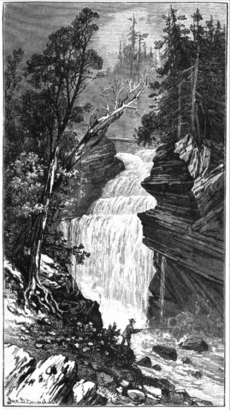
In the 1850s, brothers Elijah and Clemuel Ricketts bought 5,000 acres of land, including what is now Lake Ganoga. They built a stone house by the lake to use as a hunting lodge and tavern. They didn't know about the beautiful glens and waterfalls until around 1865, when guests discovered them while fishing.
Elijah's son, Robert Bruce Ricketts, who the park is named after, became a colonel in the army during the American Civil War. After the war, he started buying land from his father. By 1873, he owned or controlled 66,000 acres, including the glens and waterfalls. Eventually, he owned over 80,000 acres.
In 1872, R. Bruce Ricketts added a large wooden section to the stone house, and it opened as the North Mountain House hotel in 1873. Many guests were Ricketts' friends and family who stayed all summer. In 1876, Ricketts even ran the first summer school in the United States at his hotel.
The waterfalls and Ganoga Lake were the hotel's main attractions. By 1875, Ricketts had named the tallest waterfall Ganoga Falls. He eventually named 22 waterfalls, many with Native American names or names of his relatives and friends. He renamed Long Pond to Ganoga Lake in 1881. The name Ganoga is an Iroquoian word that some say means "water on the mountain."
In 1889, Ricketts hired men to build the trails along the branches of Kitchen Creek and its waterfalls. It took them four years to finish the trails and stone steps. Ricketts also built a 100-foot (30 m) observation tower at a spot he called Grand View, where people could see for 20 miles (32 km).
The Lumber Industry and Decline
For over 20 years, Ricketts had a lot of land but not much money because it was hard to transport the lumber. In 1890, he partnered with others to form the Trexler and Turrell Lumber Company. They built a sawmill and a lumber town called Ricketts nearby. Rail lines were built to the mills, which helped Ricketts financially.
The lumber company cut down almost all the trees on Ricketts' land, including parts of what is now the park. However, Ricketts had saved about 2,000 acres of old-growth forest in the glens, which were too difficult to log.
The hotel business declined after 1900, partly because many of the surrounding old-growth forests were lost in a fire. The wooden part of the hotel was torn down, and Ricketts closed the hotel in 1903. The stone house remained his family's summer home.
Between 1905 and 1907, Ricketts tried to build three dams to create hydroelectric power within the park area. These dams formed Lake Leigh, Lake Rose, and Lake Jean. Lakes Leigh and Jean were named after his daughters. However, the dams were not built well and couldn't be used for power. Ricketts famously said, "I used to be land poor, but now I'm dam poor."
Ricketts Glen Becomes a State Park
In 1913, Ricketts opened the glens and waterfalls to the public, charging a small fee for parking. After he died in 1918, his family started selling land to the state. The Pennsylvania Game Commission bought a large area for Pennsylvania State Game Lands.
In the 1930s, there were plans to make Ricketts Glen a national park, and the Civilian Conservation Corps even had a camp there. But these plans were stopped by money problems during the Great Depression and World War II.
On August 1, 1941, the Governor of Pennsylvania signed a law creating Ricketts Glen State Park. The state bought the land, including the glens and waterfalls, in 1942. The park officially opened to the public in 1944.
The state made many improvements, like rebuilding the Falls Trail and replacing old bridges. They also built a new earthen dam for Lake Jean in 1949–1950, making the lake larger. Ricketts' old dams at Lake Leigh and Lake Rose were removed. A 100-foot (30 m) steel fire tower was built at Grand View, offering views of three states and eleven Pennsylvania counties.
During the Cold War, a radar station was built in the northern part of the park (now the Red Rock Job Corps Center). It operated from 1951 to 1975 and helped protect national security. Today, the radar is still used for the nearby Wilkes-Barre/Scranton International Airport.
In 1969, the Glens Natural Area was named a National Natural Landmark, meaning it's a very special natural place. In 1993, it became a Pennsylvania State Park Natural Area, ensuring it will be protected. In 1999, Hurricane Floyd caused a lot of damage, knocking down thousands of trees. Helicopters were used to remove the fallen timber, which helped pay for a new park office and visitor center that opened in 2001.
Geology and Climate
Ricketts Glen State Park sits on two different land regions: the Allegheny Plateau in the north and the Ridge-and-Valley Appalachians in the south. The Allegheny Front is a steep slope that separates these two areas, rising up to 1,200 feet (366 m). Kitchen Creek starts on the plateau and then drops about 1,000 feet (305 m) down the Allegheny Front in just over 2 miles (3.2 km). This big drop creates the 24 named waterfalls in the glens.
The rocks you see in the park formed between 370 and 340 million years ago. At that time, this area was a shallow sea. Mountains to the east eroded, and their sand, clay, and gravel settled in the sea. Over millions of years, this sediment was pressed into the rocks we see today, like sandstone, shale, and conglomerates.
There are four main types of rock formations in the park. The highest and newest is the Mauch Chunk Formation, made of reddish shale and sandstone. Below that is the Pocono Formation, which is buff or gray sandstone. The large boulders of the Midway Crevasse, a crack in the rocks, are made of Pocono Formation sandstone.
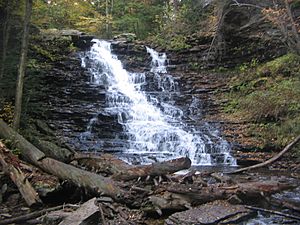
The third formation is the Huntley Mountain Formation, which is hard and resists erosion. It forms the top of the Allegheny Front. The lowest and oldest rock layer is the Catskill Formation, made of red shale and siltstone. The red rocks you see along Pennsylvania Route 487 are from the Huntley Formation.
The waterfalls in the park are usually one of two types. "Wedding-cake" falls descend in a series of small steps over thin layers of rock. "Bridal-veil" falls drop straight down over a ledge into a pool below. The harder rock on top forms the ledge, and the softer rock below is worn away by the water.
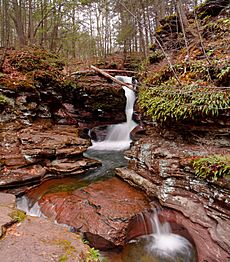
About 300 to 250 million years ago, the mountains and plateaus in this area formed when continents collided. Since then, up to 5,000 feet (1,500 m) of rock has been worn away by streams and weather. Over the last million years, at least three major ice ages have also shaped the land.
During the last ice age, glaciers covered most of the park. When they melted about 20,000 years ago, the melting ice and lakes created new channels. This changed how Kitchen Creek flowed, adding more water to it. This extra water flow has been cutting the waterfalls in the glens ever since, making them unique.
The highest point in the park is Cherry Ridge, at 2,461 feet (750 m). The highest waterfall is Mohawk Falls at 2,165 feet (660 m), and the lowest is Adams Falls at 1,214 feet (370 m).
Weather at Ricketts Glen
Ricketts Glen State Park has a continental climate. This means it can get very cold in winter and has warm summers. The average rainfall is about 40 to 48 inches (1016 to 1219 mm) per year. The highest temperature ever recorded at the park was 103 °F (39 °C) in 1988, and the lowest was -17 °F (-27 °C) in 1984. January is usually the coldest month, July is the hottest, and June is the wettest.
Ecology and Wildlife
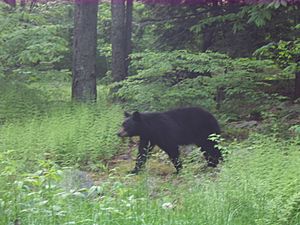
Before Europeans arrived, most of Pennsylvania was covered in forests. By 1890, Ricketts' land had the largest area of old-growth forest left in the state. Even though he made his money from cutting down trees, he saved the forests in the glens because the land was too rough to log. Many of these old-growth trees are thought to be over 500 years old, and some fallen trees have shown ages of over 900 years!
The forests in Ricketts Glen State Park are very large and provide a home for many different animals. Swampy areas have plants like black gum trees and cinnamon fern. The old-growth forest has many eastern hemlocks, eastern white pines, and oaks. The park has 85 types of shrubs, vines, and trees, including seven kinds of conifers.
The streams and lakes in the park are good for fishing, though fishing is not allowed in the glens. Kitchen Creek and Phillips Creek are known for their wild trout.
Lake Jean has fish like brook trout, brown trout, and yellow perch. Acid rain has affected the lake's water, making it more acidic. To help, the park adds powdered lime to the lake each year to make the water more neutral.
Glens Natural Area: Waterfalls and Old-Growth Trees
The Glens Natural Area is the most beautiful part of the park and covers 2,845 acres. It's a National Natural Landmark because of its amazing waterfalls and old-growth forest. Two branches of Kitchen Creek flow through deep gorges called Ganoga Glen and Glen Leigh. They meet at Waters Meet and then flow through Ricketts Glen. The old trees here can be up to 100 feet (30 m) tall and almost 4 feet (1.2 m) wide. The park has many different kinds of trees because it's where northern and southern hardwood forests meet.
The state has made sure that the Glens Natural Area is protected and kept in its natural state. This means no buildings or modern structures are allowed inside.
Hiking trails follow the creeks through the glens. Glen Leigh has eight named waterfalls, and Ganoga Glen has ten, including the 94-foot (29 m) Ganoga Falls, which is the tallest in the park. Downstream from Waters Meet, Ricketts Glen has three more named waterfalls, plus Adams Falls, which is very scenic and easy to reach.
The Falls Trail includes the trails through the glens and the 1.2-mile (1.9 km) Highland Trail. The Highland Trail connects the tops of Ganoga Glen and Glen Leigh, forming a 3.2-mile (5.1 km) loop. It also goes through the "Midway Crevasse," a narrow crack in the rocks. Hiking the entire Falls Trail loop from Pennsylvania Route 118 is about 7.2 miles (11.6 km) long.
Mammals of Ricketts Glen

Ricketts Glen State Park is an Important Mammal Area because it provides a home for many different mammals. Pennsylvania has 64 wild mammal species. The park's large forests, with hemlock valleys and hardwood mountains, are perfect for wildlife. You can often see white-tailed deer, black bears, red and gray squirrels, porcupines, and raccoons. Less common animals include beavers, bobcats, coyotes, fishers, and river otters. The park also has wild turkeys, wildflowers, butterflies, and sometimes even a timber rattlesnake.
White-tailed deer disappeared from Ricketts' land by 1912 due to too much hunting and loss of their homes. But the state brought deer from Michigan between 1906 and 1925 to bring them back. Ricketts also brought deer to the park area in 1914. By 1928, Pennsylvania's deer population grew to about one million! Now, deer are very common in the park, but they eat so many young trees and plants that it can harm the forest.
Some mammals that used to live in Pennsylvania, like bison and grey wolfs, are now gone. But beaver and river otter have been successfully brought back. Fishers were released near the park in 1995 and 1996, and they seem to be doing well. Coyotes arrived in the state in the 1930s. Black bear and wild turkey populations have also grown back thanks to the re-growth of forests.
Important Bird Area
The Pennsylvania Audubon Society has named all 13,050 acres of Ricketts Glen State Park an Important Bird Area (IBA). An IBA is a special place that provides a critical home for bird populations. Ricketts Glen is part of the larger North Mountain IBA, which is one of the biggest forests in northeastern Pennsylvania.
Bird watchers have seen 75 different bird species in Ricketts Glen State Park. This is because the park has a large forest and many different types of habitats. Bald eagles visit the park often, and some experts think they might be nesting there. The park is also a nesting place for three "rare" birds: the northern goshawk, northern harrier, and Swainson's thrush.
The park's deep forests are home to birds like the black-throated green warbler and red-eyed vireo. Two types of owls, barred and northern saw-whet, live in the deep woods. The hemlock forests in the glens are home to birds like the Louisiana waterthrush and Acadian flycatcher. Wood thrush live in the lower parts of the park, while hermit thrush live higher up. Canada warblers and black-throated blue warblers are common in the park. You can often see Common ravens flying over the forests.
Recreation and Fun Activities
Hunting, Fishing, and Boating
About 10,144 acres of the park are open for hunting and trapping. You can hunt animals like black bear, gray squirrel, wild turkey, and white-tailed deer. Common fur-bearing animals in the park include beaver, bobcat, coyote, and raccoon.
Lake Jean is a 245-acre (99 ha) lake where you can fish, ice fish, swim, and boat. You can catch panfish, trout, and bass. There are two boat launches on the lake, but you can only use electric motors, not gasoline-powered boats. You can also rent canoes, kayaks, and paddle boats. Fishing is not allowed in the Glens Natural Area.
Cabins, Camping, Swimming, and Picnics
Ricketts Glen State Park has 10 modern cabins that you can rent all year round. Each cabin has electric heat, bedrooms, a living room, kitchen, and bathroom. You need to bring your own bedding and cooking supplies. One cabin is accessible for people with disabilities.
There are 120 campsites at Ricketts Glen State Park. Each campsite has a fire ring and picnic table, and there are washhouses with toilets, showers, and laundry. Two camping areas are on the shores of Lake Jean, and one is on a peninsula. There's also a group tenting area for up to 40 people.
The 600-foot (183 m) beach on Lake Jean is open from mid-May to mid-September. There's a snack bar and restrooms at the beach. Since 2008, there are no lifeguards, so you swim at your own risk. Picnic areas with charcoal grills are available at Lake Jean and near the Falls Loop Trail.
Learning and Trails
Park experts lead guided tours from March to November. These tours teach school groups and other visitors about the wetlands, old-growth forests, waterfalls, plants, animals, and rock formations. Other programs are held at the park office, covering topics like safety around wild animals. In summer and fall, you can even go on "Ghost Town Walks" to see the ruins of the old lumber village of Ricketts.
Ricketts Glen State Park has 26 miles (42 km) of hiking trails and a 12.5-mile (20.1 km) trail loop for horseback riding. The trails range from easy, like the Beach Trail, to difficult, like the Falls Trail loop. The Falls Trail is considered one of the best hikes in Pennsylvania!
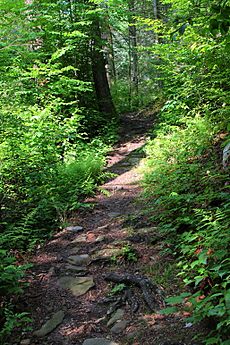
Many trails in the park are challenging, especially the Falls Trail, which is steep, wet, and slippery. Hikers need to be careful. If someone gets hurt, rescues can take many hours because of the remote and rugged land.
- Falls Trail is a 7.2-mile (11.6 km) difficult loop that takes 4 to 5 hours to hike. It has many waterfalls and goes through an old-growth forest. The park warns that it's a difficult and potentially dangerous trail. It's closed for hiking in winter but open for ice climbing. Ice climbers need special gear like an ice axe, crampons, and rope.
- Highland Trail is a 1.2-mile (1.9 km) moderate trail at the top of the Falls Trail loop. It goes through the Midway Crevasse, a narrow gap between large rocks.
- Ganoga View Trail is a 2.8-mile (4.5 km) moderate trail named after Ganoga Falls. It's an easier way to see Ganoga Falls than the Falls Trail.
- Grand View Trail is a moderate 1.9-mile (3.1 km) trail that reaches 2,449 feet (746 m), the highest point on Red Rock Mountain. It's known for beautiful flowers like mountain laurel in June and rhododendron in July. A firetower is sometimes open for even better views.
- Old Beaver Dam Road Trail is an easy 1.2-mile (1.9 km) loop trail.
- Beach Trail is an easy 0.8-mile (1.3 km) trail that connects the camping areas to the Lake Jean beach.
- Old Bulldozer Road Trail is a difficult 2.9-mile (4.7 km) trail that follows an old road built when the park was created.
- The Bear Walk Trail is an easy 1-mile (1.6 km) trail from the cabin area to Lake Rose.
- Evergreen Trail is a 1-mile (1.6 km) self-guided trail that goes through an old-growth forest, including a hemlock tree older than 1492!
- Mountain Springs Trail is a 4-mile (6.4 km) moderate trail that passes the remains of the Lake Leigh dam and goes down to Mountain Springs Lake.
- Cherry Run Trail is a 4.6-mile (7.4 km) moderate trail that goes through cherry tree groves on an old logging road.
Nearby State Parks
These state parks are within 30 miles (48 km) of Ricketts Glen State Park:
- Frances Slocum State Park (Luzerne County)
- Nescopeck State Park (Luzerne County)
- Worlds End State Park (Sullivan County)
Map
See also
 In Spanish: Parque estatal Ricketts Glen para niños
In Spanish: Parque estatal Ricketts Glen para niños


